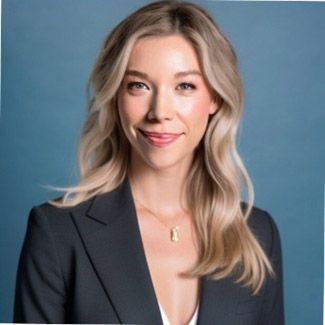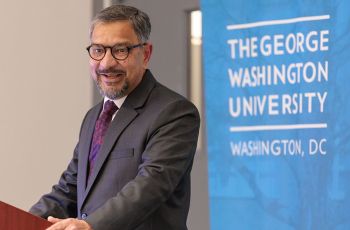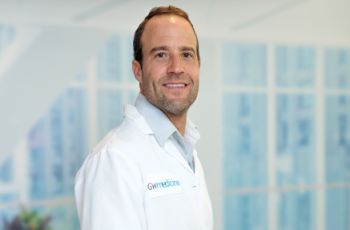To Rowan Schmincke, the paths that led her to the GW Cancer Center felt very varied and circuitous. At times, she wondered where she was going. Ultimately, those paths converged at Foggy Bottom, where her work as an oncology clinical research nurse is helping to discover cutting-edge solutions in cancer care.

What’s your story?
I grew up in Roland Park, just north of Baltimore. From fourth grade through high school, I attended an all-girls school. Then, I went to Villanova University in Pennsylvania, where I got my degree in biology. I minored in psychology and Spanish, and though I thought this path would take me to medical school, I wasn’t sure I could commit eight to 12 years of my life to studying. So, I moved to Portland, Oregon, where I enrolled in a doctoral-level chiropractic program. I studied with a cadaver and had so much respect for this person who donated their body to science. He was somebody's son, possibly a brother or husband or father. After some time, I returned to Villanova and got my nursing degree.
I became a new nurse at the University of Pennsylvania Hospital and worked in the COVID unit for three years. It was very tough. You never knew how people would respond to the disease. A 90-year-old person could get better and walk out of the hospital, while a healthy 30-year-old with no comorbidities would be gone the next morning. We saw people die every day.
It was a very isolating and frightening time. We were all terrified we’d get COVID. I’d work very long days and then go home, where I had to take off my clothes at the door and go straight to my room. My roommates would leave food at my door, and I missed so many family events. It was hard. Very, very hard.
I decided to go into clinical research because I could feel bedside burnout coming on. I was offered this position here at GW, where I get to combine my love of biology and science with nursing and patient care. It’s the best of both worlds! I’m now working towards my master’s in Clinical Research Administration.
What gets you out of bed in the morning?
My patients. Just like my COVID patients, the patients at GW Cancer Center have been through so much. Many times, a clinical trial is their last hope for a cure. They’ve tried all the standard-of-care treatments, and they’re just not working. A lot of the patients devote so much of their daily lives to their clinical trials, especially the Phase I trials. They have families and full-time jobs, and they are getting poked, and prodded, and monitored. You get to know them really well and become very close because you see them so often.
This, and my work in the COVID unit, have taught me how fragile life is and how resilient people are. I’ve learned to be grateful for my health in this moment because things could change just like that.
What is that one book that has influenced you the most?
The Book of Joy: Lasting Happiness in a Changing World, by the Dalai Lama, Desmond Tutu, and Douglas Abrams. They spent a week together, talking about their lives and the oppression they’ve encountered. Despite all their trauma, they’re happy and able to find joy. We live in an era of instant gratification, and technology creates a lack of human connection. I believe that makes people, especially here in America, very unhappy. This book talks about how happiness comes from perspective and how you have the power to control your perspective. Finding humor, humility, and joy comes from how you perceive the situations you find yourself in.
The Dalai Lama describes the Eight Pillars of Joy. When you cultivate these pillars—traits—within your heart and mind, life becomes more joyful. The author also discusses the science behind happiness, which is fascinating.
I read this book while traveling in Africa in 2018. My dad is a huge traveler, and he’s taken us all over the world. On that trip, we went to small villages, and I kept noticing how genuinely happy the villagers were. And these people live in some of the poorest regions on Earth and have very few material possessions! Yet, they were so much happier than anyone I know in the United States. Reading this book in Africa and seeing the Eight Pillars at play was amazing.
What absolutely excites you right now?
I’m very excited about the cancer prevention side of our clinical trials, which is so cool. I’m very holistic in my approach to health, and the preventative approach dovetails with this.
The main goal of these studies is to prevent people from getting cancer. We’re looking at diet and nutrition and different compounds that a person could take daily to keep cancer from developing. For instance, we’re researching how broccoli seed or green tea extract impacts the blood of heavy smokers. Do these compounds remove harmful chemicals?
I’m also excited about personalized cancer treatments. We’re taking actual tumor cells from a patient and creating a customized cancer vaccine. The vaccine attacks the neoantigens (tumor markers) on the specific tumor to invoke an immune response and kill the tumor cells. I believe personalized medicine is the future of cancer care, and it’s so exciting to be able to offer these solutions to people whose cancers have been resistant to standard-of-care treatment.
What is the most interesting thing we should know about you?
My travel experiences make up a huge part of who I am. I’ve been traveling since I was a very little girl because my Dad thought it was so important for us to see other cultures. He would take us out of school for a week and say whatever we’d learn over here or over there was much more important than what we’d learn in the classroom.
I’ve been to amazing places all over the world. The best experiences were when we went to smaller villages and towns far away from the typical tourist sites (which we would also visit). I’ve been to the DMZ between North and South Korea and ancient samurai towns in Japan. I crawled through the Củ Chi tunnels in Viet Nam and hiked the Sulkantay Trail in Peru, where they only spoke Spanish — thank God I minored in Spanish, or I would have been lost — and rode camels in Morocco. We met a man in Morocco who invited us to his house, and we sat on the roof, drinking tea with him. So I’m sitting there, my legs dangling off the side of the roof, and I see snow-capped mountains on one side and a beautiful river in the middle of these verdant pastures on the other. And I turned to my Dad and said, “This is so much beauty. I don’t think my eyes can hold it all.”



